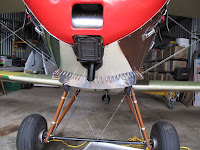I've taken advantage of some rainy days to enlarge the cowl outlet. I've increased the area to 111.4 sq. inches. It was originally 61.4 sq. in. so that's an 81.4% increase. I added 25.5 sq. in. the first go around, which made a big difference. This is almost as big of an increase, another 24.5 sq. in.
I also made a new skirt, which goes the full width of the cowl.
Before taking the cowl off I wanted to fit the new skirt to the cowl and drill all the rivet holes. Once that is done, remove the cowl, remove the old skirt, and then cut out the new opening.The straight edge of the card stock needed to curve down about 5/8" to get a nice fit to the cowl.
The ends got trimmed to match the little skirts around each exhaust pipe.
With a pattern it was easy to make a new skirt from some 0.025" 2024-T3 aluminum. The small exhaust skirts had a large tab at the outer end, with 3 rivets.
I took the blank skirt back to the plane to form the curved ends and to bend the angle on the tabs, so they would fit.
I removed the little exhaust skirts and started drilling rivet hole at the outer ends. The existing rivet holes were 1/8", but I drilled any new holes 3/32" because most of the new tab actually go inside the cowl, even though I drilled the holes with them on the outside. My idea was that using a smaller starter hole would give me a little flexibility if the holes didn't perfectly align when the tabs were on the inside. A few of the tabs had to remain on the outside because I didn't cut away all the cowling behind the skirt.
I left part of the cowl beside the exhaust pipes so I could put support brackets where the old center skirt ended.
Before riveting everything together I put the cowl back on the plane to make sure everything fit. I'm glad I did. The triangular support brackets didn't fit quite right the first time. They were easy to re-make and now it fits perfect.
The supports make the skirt much stronger and stiffer. They also allow the cowl to mount to the firewall under the plane.
With everything fitted up we're back in the attic to rivet it all together. First I Alodined the aluminum parts to reduce corrosion and allow paint to adhere better.
I like it. I'll paint it in the spring once I'm sure it works as needed.
From the back you can see which tabs were on the inside of the cowl.































No comments:
Post a Comment